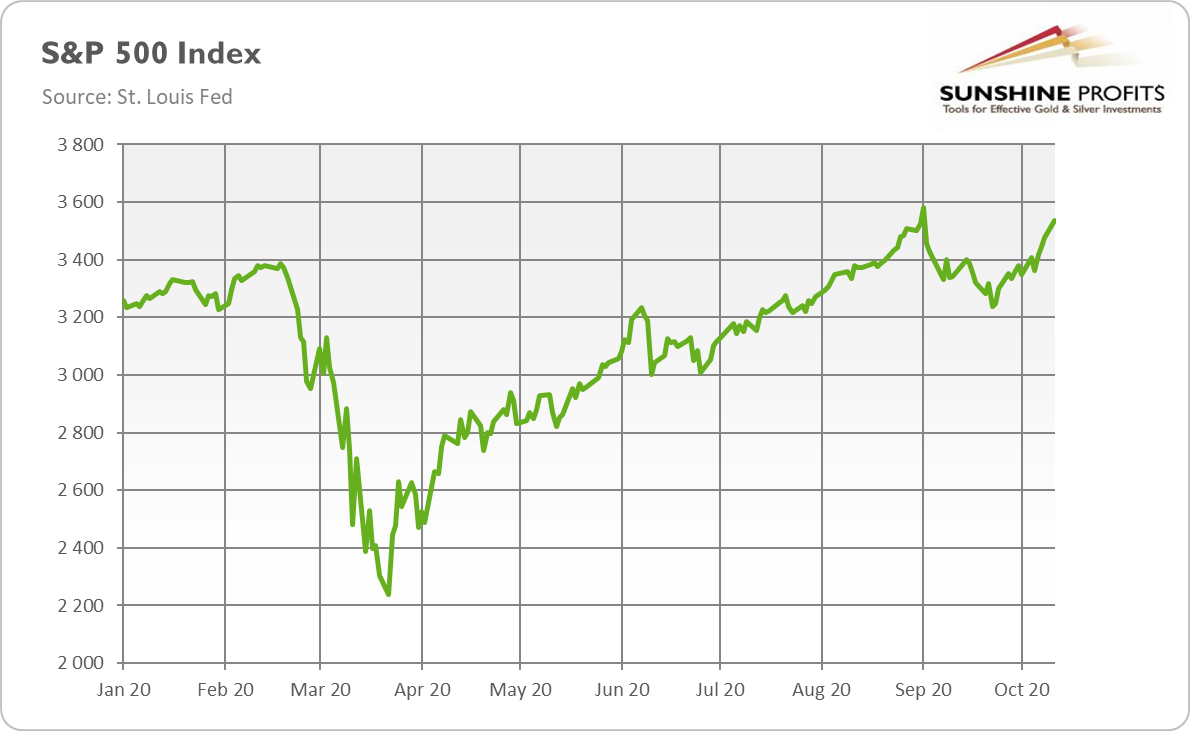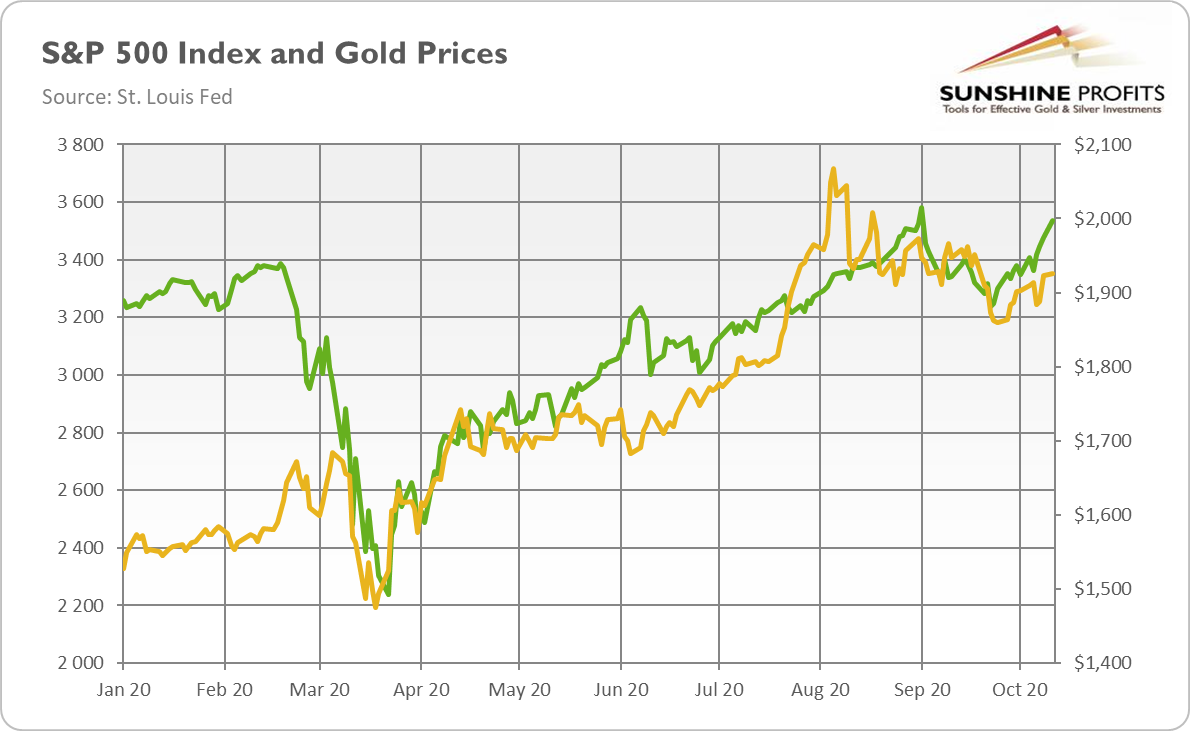Please log in to read the entire text.
If you don’t have a login yet, please select your access package.
The disconnect between the US stock market and the real economy continues. The equity valuations are surging, while the economic recovery remains fragile. As the chart below shows, the S&P 500 Index has surpassed February’s peak and it did that in August, even jumping above 3,500 points. In September, there was a correction in the stock market, but again, the equity valuations are going up despite the second wave of coronavirus infections.
So, why do we see lofty equity valuations while the real economy is struggling? Well, there are several explanations for this disconnect. The first is that the stock market is forward-looking, so the current elevated stock prices may reflect optimism about the vaccine against Covid-19, a quick end to the pandemic and clear economic recovery. Of course, this outlook may be justified, but it might also be the case that markets are excessively optimistic about the initial vaccines’ efficacy. And just as the markets downplayed the likelihood and impact of the first wave of the coronavirus, they can underestimate the consequences of the second wave in the fall and winter as well. Keep in mind that the markets also expected a quick, V-shaped economic recovery, which never materialized in the U.S.
The second explanation refers to the S&P 500 composition. You see, the simple truth is that the economic pain inflicted by the epidemic and the Great Lockdown is being borne mainly by small businesses and individual service proprietors (think restaurants, tour guides, etc.), and not by publicly traded companies. The small players simply have too little capital to survive a deep recession, while the big dogs were sitting on cash (and they were often less indebted).
Although some of the listed companies were also hit by the economic crisis, others actually benefited from the pandemic. When small and medium companies went bankrupt or struggled to survive, the big players achieved an even stronger market position than before the economic downturn.
Moreover, Big Tech has a large share in the S&P 500. The five biggest constituents of the Index – Microsoft, Apple, Amazon, Alphabet (Google’s parent) and Facebook – account for about 20 percent (or even more) of the entire market capitalization, a modern-day record of market concentration. And by the way, the coronavirus crisis was tech friendly. With millions of people locked down, companies like Amazon, Microsoft or Netflix were the clear winners. But the S&P500 Index, excluding the big tech stocks (often described by acronyms: FANG/FAANG/FAANGAM) performed much worse than the general index which was clearly driven by a few giants.
Last, but definitely not least, the Fed slashed the federal funds rate to zero and backed the private bond markets. This is why the spread between the corporate and government bond narrowed, despite the recession and increasing corporate debt. Furthermore, it is precisely why the price of gold has moved recently in tandem with equity valuations (see the chart below) – both markets were supported by negative real interest rates.
In other words, investors downplay any risks and instead focus on the current generous liquidity conditions, supported by the central banks. After all, why worry if the Fed is ready to inject liquidity at the first sign of serious problems? But this perverted dynamic may not last forever.
Now, how will the above impact the gold market? Well, the lofty equity valuations may be justified. The coronavirus crisis was tech-friendly, and markets may be right by being optimistic about the vaccine and the eventual triumph over the pandemic.
However, what goes up can also come down, especially if we don’t witness a broad-based, sustainable recovery. The current elevated valuations may result, at least to some extent – from government support and the Fed’s dovish monetary policy, which may end someday. Therefore, the stock market crash (or correction) does not have to be supportive for gold prices at all. If the equity valuations go down because Biden becomes the POTUS and he hikes the corporate tax rates, then yes, gold can act as a safe-haven asset and shine. But, if the stock market bleeds because Powell hikes the interest rates, then gold would suffer too (unless the Fed turns hawkish because of the accelerating inflation).
Therefore, yes, there might be a disconnect between the stock market and the real economy. Of course, the stock market may correct to become better aligned with the economic fundamentals, but precious metals investors should be careful what they wish for, because they just might get it. The correction does not have to support the gold prices, if it’s triggered by the normalization of the monetary policy.
Thank you for reading today’s free analysis. If you enjoyed it, and would you like to know more about the links between the economic outlook, the current (past?) crisis and the gold market, we invite you to read the November Gold Market Overview report. Please note that in addition to the above-mentioned free fundamental gold reports, and we provide premium daily Gold & Silver Trading Alerts with clear buy and sell signals. We provide these premium analyses also on a weekly basis in the form of Gold Investment Updates. In order to enjoy our gold analyses in their full scope, we invite you to subscribe today. If you’re not ready to subscribe yet though and are not on our gold mailing list yet, we urge you to sign up. It’s free and if you don’t like it, you can easily unsubscribe. Sign up today!
Arkadiusz Sieron, PhD
Sunshine Profits: Analysis. Care. Profits.
-----
Disclaimer: Please note that the aim of the above analysis is to discuss the likely long-term impact of the featured phenomenon on the price of gold and this analysis does not indicate (nor does it aim to do so) whether gold is likely to move higher or lower in the short- or medium term. In order to determine the latter, many additional factors need to be considered (i.e. sentiment, chart patterns, cycles, indicators, ratios, self-similar patterns and more) and we are taking them into account (and discussing the short- and medium-term outlook) in our Gold & Silver Trading Alerts.





